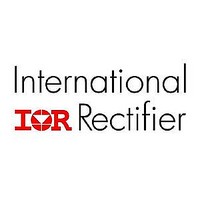OM9373 International Rectifier Corp., OM9373 Datasheet - Page 11

OM9373
Manufacturer Part Number
OM9373
Description
Full-featured Power Module For Direct Drive Of 3-phase Brushless Dc Motor F-43 / Mp3-43l Packages
Manufacturer
International Rectifier Corp.
Datasheet
1.OM9373.pdf
(14 pages)
HALL-EFFECT INPUTS (H1, Pin 22; H2, Pin 21; H3,
Pin 20) - Each input has an internal pull-up resistor
to the +5V Reference. Each input also has an
internal 180pF noise filter capacitor to Ground. In
order to minimize the noise which may be coupled
from the motor commutation action to these inputs, it
is strongly recommended that additional external
filter capacitors, whose value is in the range of
2200pF, be connected from each Hall-Effect Input
pin to Ground. Whatever capacitor value is used, the
rise/fall times of each input must be guaranteed to
be less than 20us for proper tachometer action to
occur. Motors with 60 degree position sensing may
be used if one or two of the Hall-effect sensor
signals is inverted prior to connection to the Hall-
Effect Inputs.
SPEED INPUT (Pin 23) - This pin is connected to the
“+” input of a voltage comparator, whose threshold
is 0.25Vdc. As long as the Speed Input is less than
0.25V, the direction latch is transparent. When the
Speed Input is greater than 0.25V, then the direction
latch inhibits all changes in direction. It is recommeded,
especially while operating in the half control mode,
that the Tachometer Output is connected to the
Speed Input via a low-pass filter, such that the
direction latch is transparent only when the motor is
spinning very slowly. In this case, the motor has too
little stored energy to damage the power devices
during direction reversal.
DIRECTION INPUT (Pin 24) - This input is used to
select the motor direction. This input has an internal
protection feature: the logic-level present on the
Direction Input is first loaded into a direction latch,
then shifted through a two-bit shift register before
interfacing with the internal output phase driver
logic decoder. Also, protection circuitry detects
when the input and the output of the direction latch
or the 2-bit shift register are different, and inhibits
the Phase Outputs (i.e. Hi-Z) during those times. This
www.irf.com
GROUND (Pin 19) - The voltages that control the
OM9373 are referenced with respect to this pin. All
bypass capacitors, timing resistors and capacitors,
loop compensation components, and the Hall-effect
filter capacitors must be referenced as close as
possible to pin 19 for proper circuit operation.
Additionally, pin 19 must be connected as close as
physically possible to the Motor Return, pins 27 and
28.
feature may be used to allow the motor to coast to a
safe speed before a direction reversal takes place.
Power stage cross-conduction ( current "shoot-through”
from Vmotor to Ground through simultaneously enabled
pull-up and pull-down drivers ) is prevented by the shift
register as it is clocked by the PWM oscillator, so that a
fixed delay of between one and two PWM oscillator clock
cycles occurs. This delay or "dead-time" guarantees that
power-stage cross-conduction will not occur.
CURRENT SENSE OUTPUTS (CSH, Pin 25; CSL,
Pin 26) - The Current Sense Outputs produce a
differential voltage equal to the motor current times
the sense resistance value (5m: nominal). There is
an internal 0.018PF filter capacitor across pins 25
and 26, and two 100: series resistors, one between
each pin and each end of the current sense resistor.
To configure the current sense amplifier for cycle-
by-cycle current limiting and/or overcurrent protection,
connect pin 25 to pin 12 (ISH) and pin 26 to pin 13
(ISL).
MOTOR RETURN (Pins 27 and 28) - These pins are
connected to the most negative terminal of the
motor supply (Vm-). This connection is electrically
isolated from the logic ground internal to the OM9373
package to minimize, if not eliminate, noise on the
logic ground. The connection to the logic ground is
made by the user external to the package (refer to
Ground (pin 19)). In order to minimize packaing
losses and parasitic effects, it is essential that both
of these pins be firmly connected to the motor supply
Ground, with as short a connection as physically
possible.
SOURCE (Pins 29, 34, 35, 39 and 40) - The source
pins form the low-side connection of the pull-down
switches associated with each Phase Output. Because
of the switching current capability of the OM9373, all
5 pins should be externally connected together with
a low impedance bus to minimize losses and voltage
differentials. Also, due to layout design considerations,
pin 29 is internally connected to the "top" of the internal
current-sense resistor.
OM9373
11





